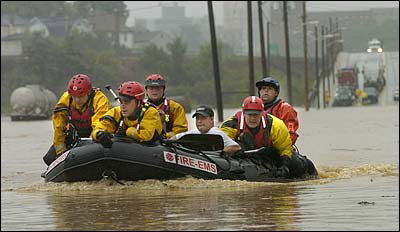
Courtesy of the Virginia Municipal League
Appendix 12
Emergency Management
Emergency management in the face of potential and actual disasters is something for which all local governments must be prepared. Emergency management covers both emergencies and disasters, although the distinction between them is substantial. Emergencies are occurrences that can be handled adequately with community resources, as in the case of a fire, localized flooding, or an auto accident. However, disasters – major floods or earthquakes – may require state or federal assistance.
Water rescue  Courtesy of the Virginia Municipal League |
Preparing for such dire occurrences is most effective when emergency management is an integral part of everyday local government operations. Because disasters and emergencies are never planned, the most opportune time for local governments to prepare for them is before they happen.
The primary functions of emergency management are: